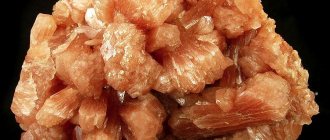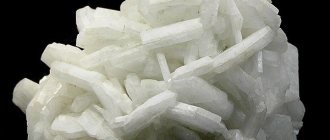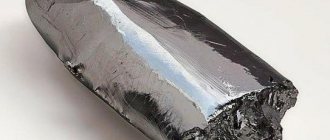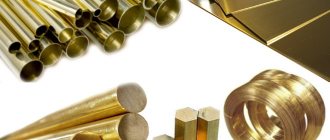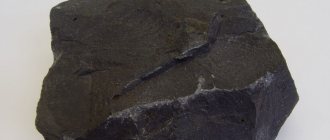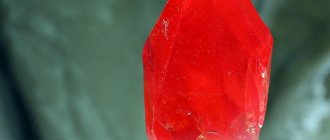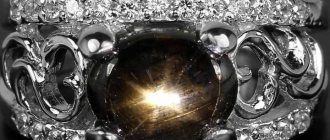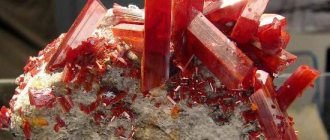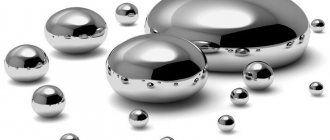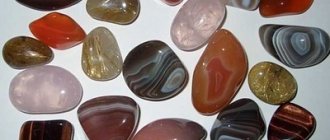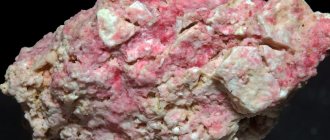Limonite (brown iron ore, bog ore) is a mineral from the group of iron oxides, which, due to its different origin and inclusions of chemical elements, does not have a constant formula.
The name of the stone characterizes its original relationship to ores of swamp and meadow origin and is translated from Greek: “leimon” - “meadow”. The origin of the limonite rock has a history of 25 million years.
Physical and chemical properties
The composition of limonite (FeO·OH·nH2O) contains goethite, lepidocrocite and water released during the adsorption process, while the proportion of iron oxides reaches 90%. In addition to these elements, the mineral almost always contains impurities of alumina, decomposed organic matter and silicon hydroxides. Oxide of chromium, titanium, nickel and phosphorus is rarely present in small quantities. Due to this, the color of limonite varies from yellow-brown to dark brown, which in dense crystals reaches black. Thin chips may show through in red or brown shades.
Limonite geode
Limonite is characterized by a silky, matte or metallic luster, while sinter formations create the effect of a rainbow shimmer on the surface of the stone. The mineral has different hardness levels. For earthy formations, the hardness coefficient does not exceed 2 points, while for sinter-type crystals with a conchoidal fracture, the indicator reaches 5 points.
The properties of the mineral are such that it has no cleavage, and the line on the fracture has a red-brown or yellow tint. It has no magnetic properties, but when heated it begins to magnetize. It also dissolves instantly under the influence of acids, and when heated it releases water.
Swamp Ore
Ferric oxide hydrate is known by several names: limonite, legume or bog ore, brown iron ore, needle iron ore, goethite. The last name comes from the name of Johann Wolfgang Goethe, a poet, thinker, philosopher and natural scientist. The word "limonite" comes from the Greek "leimon", which means "meadow", as it is found in meadow and swamp ores.
The oldest name for ferric hydroxide is onegit, it is almost never used.
Physical research methods
Ancient methods. It melts under the soldering tube and becomes highly magnetic with prolonged heating.
Water is released in a glass tube, turns red, and turns into anhydrous Fe2O3.
Color ocher-yellow brown black Origin of weathering crust chemogenic Application ferrous metals mineral pigments Chemical elements /fe3+iron ion Hydrogen H Oxygen O
Physico-chemical characteristics of limonite
According to its chemical composition, limonite belongs to iron oxides.
Other similar minerals were found in its composition, for example, goethites and lepidocrocites, and adsorbed water. In general, limonite is an amorphous mineral, without a permanent stable chemical composition. For this reason, limonites are often not classified as a separate mineralogical group. In addition to goethites, they may also contain alumina, clay minerals, silica hydroxides, and decomposition products of organic compounds. Slightly less common are the oxides of titanium, phosphorus, chromium and nickel. The color palette of limonite is quite diverse, it includes shades of yellowish-brown and dark brown. Its dense masses are usually very dark, almost black. The luster of different limonites also differs; there are matte, metallic, silky and even resinous samples.
— Advertising —
The hardness of limonite is also not fixed due to its variable chemical composition; natural samples are soft, medium hard and hard. According to the Mohs scale, it can be assessed in the range of 1.5-5.5.
Limonite intergrowths are not characterized by cleavage. They are soluble in hydrochloric acid. At the break they are earthy or conchoidal.
A distinctive feature of limonite is that the mineral is non-magnetic, but if the sample is heated for a sufficiently long time, it may develop magnetic properties.
Physical properties Optical
The color of limonite and goethite is dark brown to black. Powdery or ocher limonite, often formed during physical weathering due to dense black limonite and iron silicates, has a rather light yellow-brown color. As comparative chemical and X-ray studies have shown, this ocher variety is no different from dense limonite.
- The features of goethite are brown with a reddish tint. Limonite mostly has a light brown or yellow-brown color.
- The luster of goethite is diamond to semi-metallic. On the surface of kidney-shaped or stalactite masses of limonite, goethite is often found in the form of shiny, pitch-black thin crusts.
Nm = 2.35–2.39.
- The shimmer is velvet (velvet blende), waxy, matte.
- Transparency. Opaque
Chemical composition
The chemical composition of brown iron ore is represented by iron (III) oxide and water in the following proportions: Fe2O3 – 86-89%, H2O – 10-14%. The proportions may vary, and therefore several varieties of limonite were previously identified. Limonite is now considered a hydrated version of goethite.
Goethite, or as it is otherwise called needle iron ore, is the main component of limonite. This mineral got its name in honor of the German writer I.V. Goethe, who was interested in mineralogy and had a large collection of stones. The formula of goethite is FeO(OH). The significant presence of this mineral in the aggregate makes limonite harder, because the hardness of goethite is 5-5.5 on the Mohs scale. Rhombic planaxial syngony.
Mechanical
- The hardness of goethite is 4.5–5.5, limonite - 4–1 (depending on the physical state).
- Density. 4-4.4.4, for limonite it ranges from 3.3 to 4.0.
- The cleavage of goethite along {010} is perfect.
- Kink. Rough, uneven, earthy.
Chemical properties. Behavior in acids. They dissolve slowly in HCl.
Other properties: it is often possible to observe in one sample the transitions of dense varieties into earthy ones; the properties of the mineral can accordingly vary within one sample.
Formula of goethite and limonite
Goethite - α-FeOOH or HFeO2
Limonite - HFeO2. aq or FeO*nOH
Crystallographic characteristics
Rhombic syngony; rhombodipyramidal mmm. V. With. Etc. gr Pbpt. a0 = 4.64; b0 = 10.0; с0 = 3.03.
The crystal structure is similar to the structure of diaspore.
Types of stone
Depending on the composition and density, two types of limonite are distinguished:
- “Glass brown head” - round growths that are smooth to the touch, thereby resembling a head and are distinguished by a silky shine and brown color.
- “Yellow Ocher” is a brittle yellow-orange mineral that easily grinds into powder. It is widely used among artists as a source of natural paints.
Based on color, limonites are divided into the following subspecies:
- lemon yellow;
- yellow-ochre;
- gray-brown;
- dark brown;
- orange-brown.
Mineral deposits
Limonite is of exogenous origin, forming deposits in marshy areas, as well as on the coasts and bottom of seas and lakes in sedimentary deposits.
Numerous mineral deposits are located in Russia. On an industrial scale, limonite is mined in the Western regions of Siberia, in the Tomsk region (Bakcharskoye and Kolpashevskoye deposits). In the Urals, stone deposits were formed in the process of chemical weathering of siderite, pyrite and main igneous rocks (Bakalskoye, Orsko-Khalilovskoye, Karabashskoye, Alapaevskoye and Kyshtymskoye deposits).
Deposits of sedimentary origin are developed in marshy and lake areas of the Tula and Lipetsk regions, Karelia and Bashkortostan. In the vicinity of Kursk, samples of ocher and red lead are mined.
Abroad, significant volumes of limonite are mined in India, Canada, Brazil, Venezuela, Angola, Brazil, Congo, Lorraine, Alsace and Cuba.
Geological distribution
The largest deposits of oxide iron ores are confined to Precambrian deposits (Kursk Magnetic Anomaly, Krivoy Rog, etc.) of ancient geosynclinal regions. These iron ores are represented mainly by siliceous-ironous (jaspilite) rocks. They are found only in Cambrian (Khingan, Far East) deposits. In the Paleozoic era, oolitic oxide marine iron ores accumulated. In the Mesozoic and Cenozoic eras, in addition to oolitic ores, lake-marsh deposits and weathering crust ores begin to form. For example, the iron ore deposits of the Southern Urals are confined to Jurassic or similar age deposits. At the end of the Tertiary period, the accumulation of iron ores on the Kerch Peninsula occurs.
Siderts in the post-Proterozoic periods are known from Carboniferous deposits of the central regions of the European part of Russia, from the Subpolar Urals, Jurassic deposits of Dagestan, Jurassic and Cretaceous deposits of the Vyatka-Vychegda watershed, Lower Cretaceous rocks of the Western Caucasus and from the upper Neogene strata of the Taman and Kerch Peninsulas.
Chamosite ores are formed in the coastal parts of sea basins in conditions of lack of oxygen among iron-rich sediments. Known in Silurian and Devonian deposits of the Western Urals. The content of chamosites in Kerch ores is significant.
Application of limonite
The stone is classified as brown iron ore, which is used in the metallurgical industry for the production of steel and cast iron alloys. At enterprises with modern technologies, the volume of consumption of limonite for steel smelting is gradually reduced due to the presence of phosphorus in the composition of the mineral. The properties of earthy limonite also make it possible to use it as a molding material, and in the chemical industry to make paints.
The amazing shades and shapes of raw crystals make limonite in demand in jewelry and collectibles. Beautiful jewelry is made from it - pendants, pendants, men's rings and rings, earrings and bracelets. The gem combines most successfully with silver. Collectors are of particular interest in pseudomorphoses of the mineral based on marcasite and pyrite.
Price of products
Limonite is affordable, so anyone can buy it. Depending on the quality of the stone, as well as the size and type of product, the price varies within:
- 0.15-0.2 $ - for tumbling 10-20 mm in size;
- from $2 - for a stone processed with a cabochon measuring 30 mm or more;
- 10-30 $ - for an intergrowth of limonite with rock crystal;
- $15 – for earrings in silver with a stone up to 30 mm;
- from $30 per bracelet depending on the size of the stones.
Jewelry with high-quality gemstones is more expensive. Their price is $250 and above.
Main mining methods
Minerals are extracted by open-pit mining by organizing quarries. The cheapest way to obtain it is blasting. To do this, an explosive device is placed into the rock using drilling and then an explosion occurs. A more economical option is to use an air cushion. In this case, a narrow channel is drilled into the rock, into which a reservoir of pressurized air is placed. And finally, the most expensive is extraction using a stone cutter.
Medicinal properties
Amethyst pendant with limonite inclusions
Lithotherapists believe that regular use of limonite helps normalize the psycho-emotional state. The energy of the stone helps:
- reduce the manifestation of nervous disorders;
- normalize sleep;
- eliminate the manifestation of aggression, irritability, unreasonable fears;
- increase stress resistance;
- get rid of apathy and pessimistic attitude.
The properties of the gem also help strengthen the immune system, improve blood circulation and the functioning of the vascular system, normalize blood pressure, and increase hemoglobin levels.
Magic of stone
Limonite - brown iron ore
Esotericists practically do not use limonite in rites and rituals because of its weakly expressed magical properties. However, the power of the stone is enough for ordinary people to use it.
Limonite amulets protect their owner from the “evil eye,” envy, damage, evil intentions of ill-wishers, dangers and other troubles. The stone brings harmony to family life and helps spouses improve relationships after quarrels.
For people whose profession involves risk, the mineral will protect them from injuries and accidents. An amulet with it will give athletes, rescuers, and climbers confidence in their own abilities and actions.
Limonite is recommended to be worn as a talisman by people of creative professions. The energy of the stone radiates positivity, inspires new and unconventional approaches to art, and promotes the development of imagination.
In order for limonite to maximize its properties, you need to carry it with you at all times.
Interesting Facts
Many minerals have a rich history. In ancient times, priests used stones in their rites and magical rituals. But limonite cannot be called popular among clergy. Also, the stone is not in demand in astrology.
Some varieties of limonite have unusual structures, making them attractive to collectors. 5 years ago, one of these stones was sold to an unknown collector for a record amount of several tens of thousands of dollars.
The history of limonite is very ancient and dates back more than 10 million years. Even in the times of the pagans, the mineral was used for rituals. For these purposes, it was subjected to heat treatment and further grinding. In one of these treatments, it was discovered that the stone could be used to obtain iron. It was this fact, according to many scientists, that gave rise to the Iron Age. The reliability of this hypothesis is still being debated today.
How to care for stone
Limonite in rock crystal
Limonite should be treated with care so that it retains its original beauty and color for a long time. To do this, it is recommended to follow simple rules:
- Designate a separate place for storing limonite. This could be a small box with soft upholstery inside, a case or a velvet bag.
- Remove jewelry with a gem while playing sports, taking a shower or bath, visiting a pool, sauna or bathhouse.
- Avoid exposure to mechanical factors and sudden temperature changes. The stone should be protected from impacts, falls and scratches.
- Do not wear limonite in direct sunlight, which has a negative effect on its structure and color.
- In case of contamination, wash the stone with soapy water and running water, and then be sure to wipe dry with a cloth. Do not use abrasive products or solutions containing acids for cleaning.
Diagnostic parameters
Such characteristics mean a set of external parameters, as well as physical properties by which the analyzed mineral differs from others. In the case of red iron ore, these include:
- in terms of external indicators, it is similar to black stone, volcanic glass (differs in greater density);
- the rock is hard, but fragile (when a piece of rock is passed over porcelain, a mark will remain on the glass);
- it leaves a red color on the ceramic plate;
- Unlike magnetite, it is weakly attracted by a magnet.
